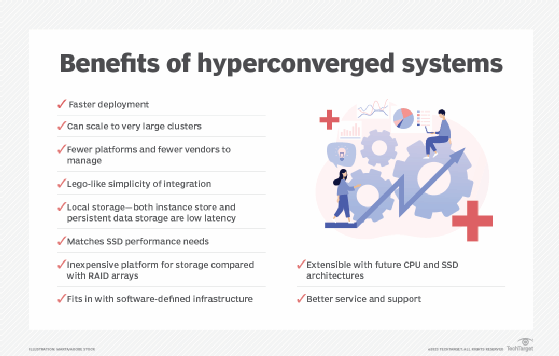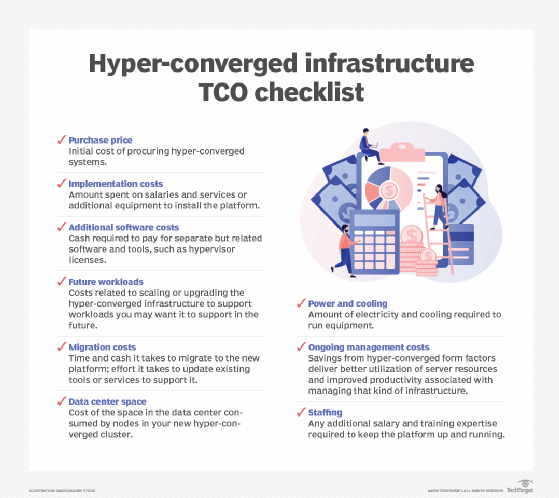
Fotolia
Top hyper-converged infrastructure TCO factors to consider
A lot of factors for estimating hyper-converged total cost of ownership are fairly straightforward, others less so. Follow these guidelines to get started on this complex process.
Determining the true hyper-converged infrastructure total cost of ownership is perhaps one of the biggest challenges you'll face when assessing hyper-converged appliances. Not only must you take into account the cost of the appliance itself, but also what it takes to deploy, maintain and scale the system over the long term.
The cost of the product itself will depend on whether you purchase it outright or take a consumption-based approach. With consumption-based pricing, you have fewer upfront costs, but the ongoing fees can add up quickly. You must also take into account any optional components or services you want to include, as well as the level of support when opting for a hyper-converged infrastructure appliance that requires additional fees. Also be sure to factor in software licenses and any hidden costs that might come with the system.
Calculating the total cost of ownership (TCO) for a hyper-converged infrastructure appliance can get tricky when trying to estimate future workloads and what they might require in terms of scaling or upgrading the system. The vendor might offer you a great deal for the initial appliance, but when it comes time to adding nodes or upgrade components, the discounts go out the window. Hyper-converged vendors have little incentive to drop prices once customers are locked into their products. Unless you can wrangle specific guarantees out of the vendor when first purchasing the appliance, you could face significant sticker shock down the road. You must try to anticipate what those costs will be when estimating hyper-converged infrastructure TCO.

Another important factor to consider is the hit on IT resources. Will special training be necessary? Will you need to bring on additional expertise? Even if you answer no to both questions, there is still a learning curve to account for, as well as the time it takes to migrate to the new platform. Also consider the effort it will take to update your existing tools or services to accommodate the new system.
An additional challenge with estimating costs is trying to determine what it means to move to a new data center administrative model. You may currently separate compute, storage and security efforts into separate disciplines in an organization, but hyper-convergence brings them together in a single unit, forcing you to rethink how to carry out day-to-day operations.
At the same time, you need to estimate how the hyper-converged appliance will reduce your costs. For example, hyper-converged infrastructure can make better use of resources, leading to a smaller data center footprint and lower power consumption. In addition, once the system is up and running, fewer IT resources should be required to keep everything going. Even if you need to scale up systems or replace components, the process should be far less painful than with traditional systems. An effective hyper-converged appliance can also lead to greater end-user productivity.

Many of these factors are fairly straightforward when it comes to estimating expenses, such as what it will cost to purchase a hyper-converged appliance, but other estimates come with much less certainty. Chances are your hyper-converged infrastructure TCO figures will span a wider range than what you would usually prefer.
Many hyper-converged vendors offer TCO calculators for their products. While some of these might be useful as tools on your journey to hyper-converged ownership, independently determining total cost of ownership using the factors most relevant to your situation is essential. So, to help narrow the gap, try to find out what other customers have experienced.
They might provide insights that can help you arrive at more exact estimates. Even with this information, however, calculating a true hyper-converged infrastructure TCO is a complex process that requires careful consideration of every possible variable.








